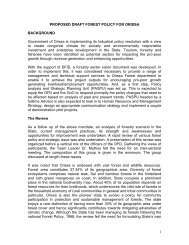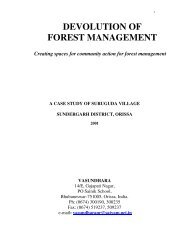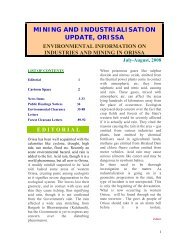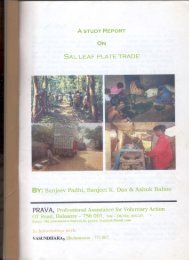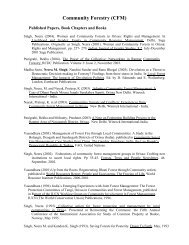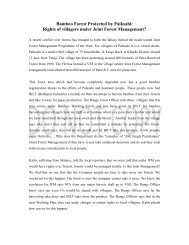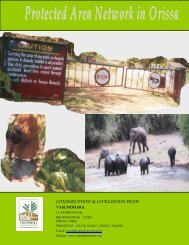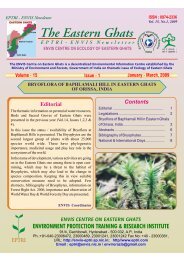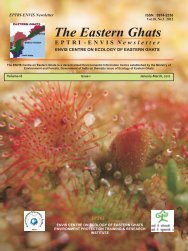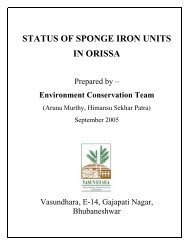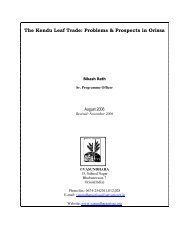Bamboo in Orissa: Trade and Livelihood Perspective - Vasundhara
Bamboo in Orissa: Trade and Livelihood Perspective - Vasundhara
Bamboo in Orissa: Trade and Livelihood Perspective - Vasundhara
Create successful ePaper yourself
Turn your PDF publications into a flip-book with our unique Google optimized e-Paper software.
All rights reserved by VASUNDHARA(www.vasundharaorissa.org). For any clarification, contact author at sunlit1968@yahoo.co.<strong>in</strong><br />
<strong>Bamboo</strong>s are the tallest grasses of the world. They are also among world's fastest grow<strong>in</strong>g<br />
species. The stems are known as culms, <strong>and</strong> the bush to which the culms are conf<strong>in</strong>ed <strong>in</strong> a<br />
unit, is known as 'clump'(buda or madhi <strong>in</strong> Oriya). The culms can grow @7.5 cm per day<br />
(CSIR 1988, The Wealth of India,Vol.2, p.11). Flower<strong>in</strong>g is seen usually once <strong>in</strong> a lifetime,<br />
<strong>and</strong> after flower<strong>in</strong>g, the bamboos gradually die hav<strong>in</strong>g reached an over-matured<br />
stage(except <strong>in</strong> few cases).<br />
The strength of culms <strong>in</strong>creases from about 6 months <strong>and</strong> reaches the maximum <strong>in</strong> 3-4<br />
years. Tensile- <strong>and</strong> crush<strong>in</strong>g strength, as well as hardness is more <strong>in</strong> the outer layer of<br />
culms than <strong>in</strong> the <strong>in</strong>ner layers. Fungal <strong>and</strong> <strong>in</strong>sect attacks deteriorate the strength.<br />
Varieties:<br />
Out of approx. 1250 species of bamboo found <strong>in</strong> the world, about 130 are found <strong>in</strong><br />
India(Mohanty T.L. 2004, Sundarakani Baunsha Chasha, The Sambad, 21-8-04). In<br />
<strong>Orissa</strong>, the number of bamboo species is however limited to 6 or 7 among which only 3 or<br />
4 are common.<br />
Dendrocalamus strictus (salia or salimbo) <strong>and</strong> Bambusa arund<strong>in</strong>acea/bambos (kanta, daba<br />
or balia ) are found wild as well as cultivated <strong>in</strong> <strong>Orissa</strong>. B.nutans(sundarkani),<br />
B.vulgaris(badi baunsha or golden bamboo) <strong>and</strong> B.tulda(del<strong>in</strong>gi, balangi or<br />
Cephalostachyun pergracile)) are less common <strong>in</strong> the state but are mostly encountered <strong>in</strong><br />
the village areas. The <strong>in</strong>troduced species are Bambusa balcoa, B.gigantius <strong>and</strong><br />
B.longispathus(Mohanty D. 2003, Policy <strong>and</strong> Operational issues <strong>in</strong> <strong>Bamboo</strong> Sector <strong>in</strong><br />
<strong>Orissa</strong>, paper presented <strong>in</strong> a workshop at Bhubaneswar <strong>in</strong> April 2004).<br />
Salia is otherwise known the Male <strong>Bamboo</strong>, <strong>and</strong> is hardiest of all Indian bamboos. It can<br />
grow almost on all types of soil provided the latter is well-dra<strong>in</strong>ed. On dry, poor quality<br />
soil the culms are solid whereas on fertile <strong>and</strong> moist soils they are rather hollow. The<br />
height varies from 20 ft. to 50 ft.; <strong>and</strong> diametre, from 1 to 3 <strong>in</strong>ches(CSIR 2003 repr<strong>in</strong>t, The<br />
Wealth of India, Vol.III, p.33). This species is also known as the Hill <strong>Bamboo</strong> s<strong>in</strong>ce it is<br />
often found on hill slopes.<br />
Daba, otherwise known as the Female <strong>Bamboo</strong>, rather prefers moist <strong>and</strong> rich soil(hence, it<br />
is more abundant on stream banks or nalla sides); but as an exception it has been found <strong>in</strong><br />
abundance on hills along the Khurdha-Barbara belt. Culms may be 20 to 30 metre <strong>in</strong><br />
length, <strong>and</strong> 15-17 cm <strong>in</strong> diametre(CSIR 1988, The Wealth of India,Vol.2, p.33). Thorns<br />
make the clump virtually impenetrable.<br />
Sundarkani is much preferred by growers because it has longest <strong>and</strong> wider culms. It may be<br />
noted that B. nutans is scarcely dist<strong>in</strong>guishable from B.tulda (Saxena H. <strong>and</strong> Brahmam. M.<br />
1996, The Flora of <strong>Orissa</strong>, Vol.IV, p.2267).<br />
The artisans of Belabani(Nayagarh district) dist<strong>in</strong>guish the follow<strong>in</strong>g varieties of bamboo<br />
with regard to their professional need:<br />
4



